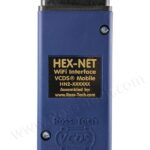The Ross-Tech VCDS HEX USB CAN interface is a vital tool for diagnosing and troubleshooting issues in Volkswagen, Audi, Seat, and Skoda vehicles. This article delves into the differences between older generations like the HEX+CAN and the newer VCDS HEX V2, focusing on the advancements and advantages of using a Ross-Tech VCDS HEX USB CAN interface.
Enhanced Performance with CAN-Based Cars
The core of both the HEX V2 and HEX-NET interfaces is a powerful 32-bit microcontroller. This advanced hardware significantly boosts communication speed, especially in vehicles utilizing CAN (Controller Area Network) technology. Older interfaces like the HEX+CAN may struggle with newer models due to communication limitations. However, for older vehicles relying on K-Line communication, the speed difference is minimal as the control module itself limits the data transfer rate.
Future-Proofing Your Diagnostic Capabilities
The automotive industry is continuously evolving, with newer car models incorporating more complex systems and communication protocols. The HEX+CAN interface, while functional for older vehicles, faces compatibility challenges with models from 2016 onwards. The Ross-Tech VCDS HEX USB CAN V2 addresses this issue, ensuring compatibility with current and future vehicles. Upgrading to a Ross-Tech VCDS HEX USB CAN interface guarantees access to the latest diagnostic features and functionalities. Eventually, older interfaces like the HEX+CAN will no longer receive software updates or support. While legacy VCDS software versions may remain available, they won’t include new features or support for the latest vehicle models.
VCDS HEX V2 vs. HEX-NET: Key Distinctions
Both the VCDS HEX V2 and HEX-NET utilize the same powerful microcontroller, guaranteeing fast and reliable communication. The primary difference lies in connectivity. The HEX-NET offers built-in Wi-Fi and onboard storage, enabling wireless diagnostics using VCDS-Mobile. This allows users to perform diagnostics with various devices, including smartphones, tablets, and laptops, through a web browser interface. The V2 maintains a direct USB connection to the computer, providing a more traditional diagnostic setup. Choosing between the V2 and HEX-NET depends on individual needs and preferences. For those seeking wireless flexibility and mobile diagnostics, the HEX-NET presents a compelling option. If a wired connection suffices, the V2 offers a reliable and cost-effective solution.
Conclusion: Investing in the Right Diagnostic Tool
Investing in the right diagnostic interface is crucial for any automotive enthusiast or professional. While the older HEX+CAN served its purpose, the Ross-Tech VCDS HEX USB CAN V2 offers significant advantages in terms of speed, compatibility, and future-proofing. Choosing a Ross-Tech VCDS HEX USB CAN interface ensures you have the tools necessary to diagnose and maintain modern vehicles effectively.

